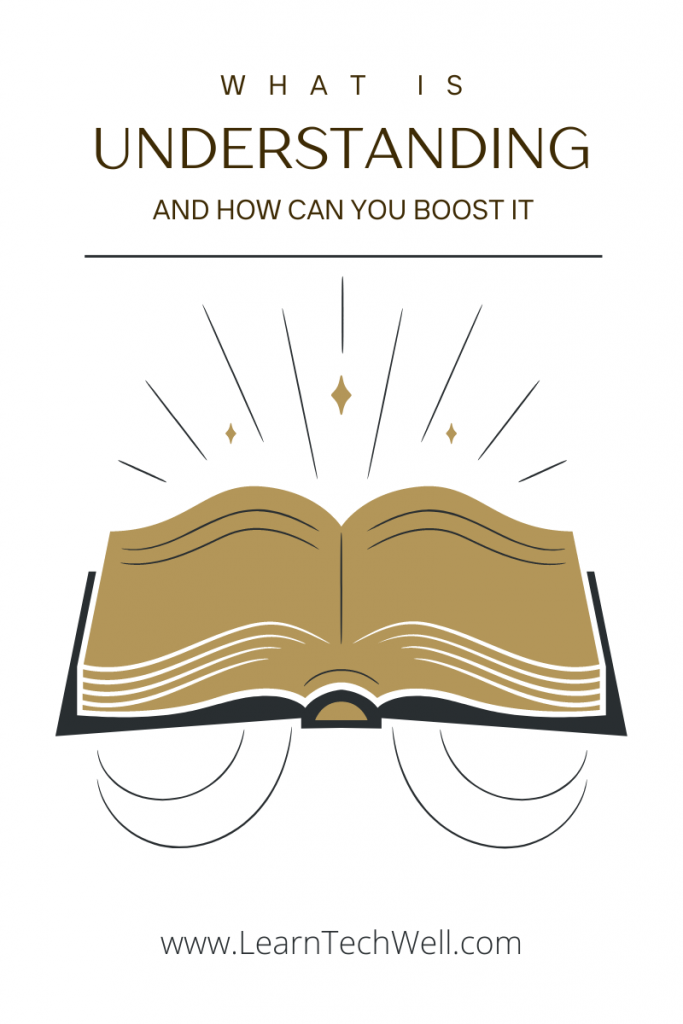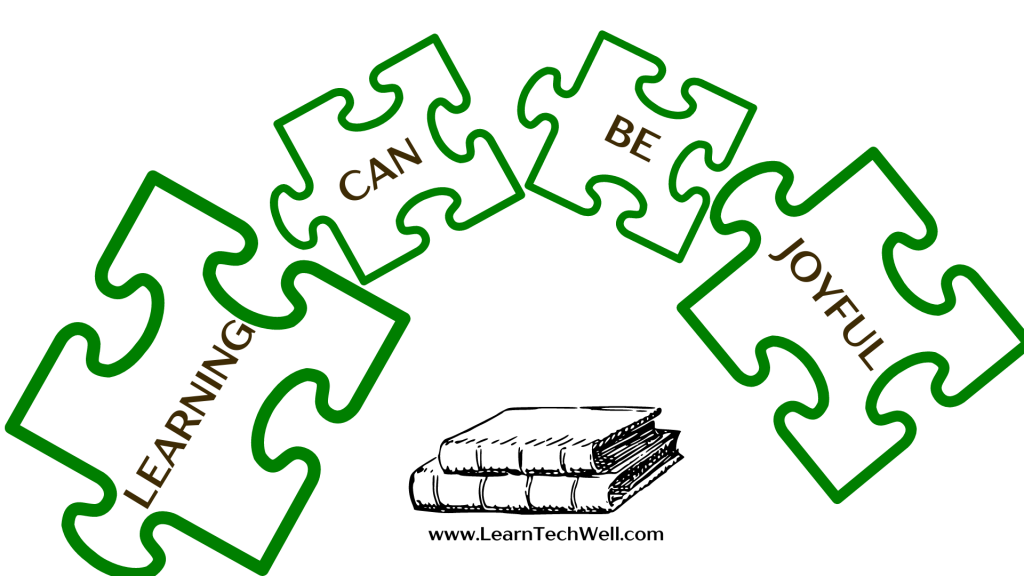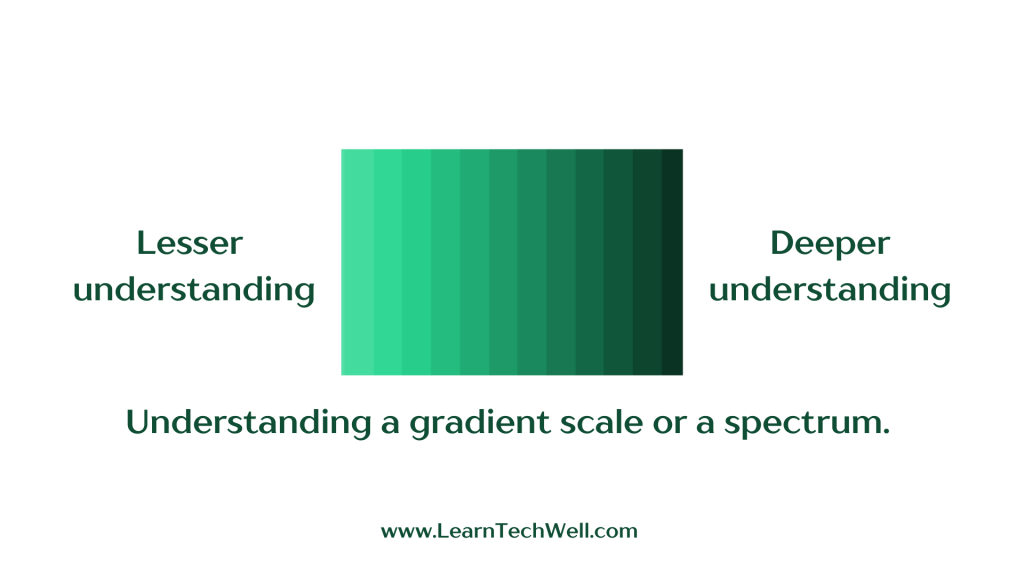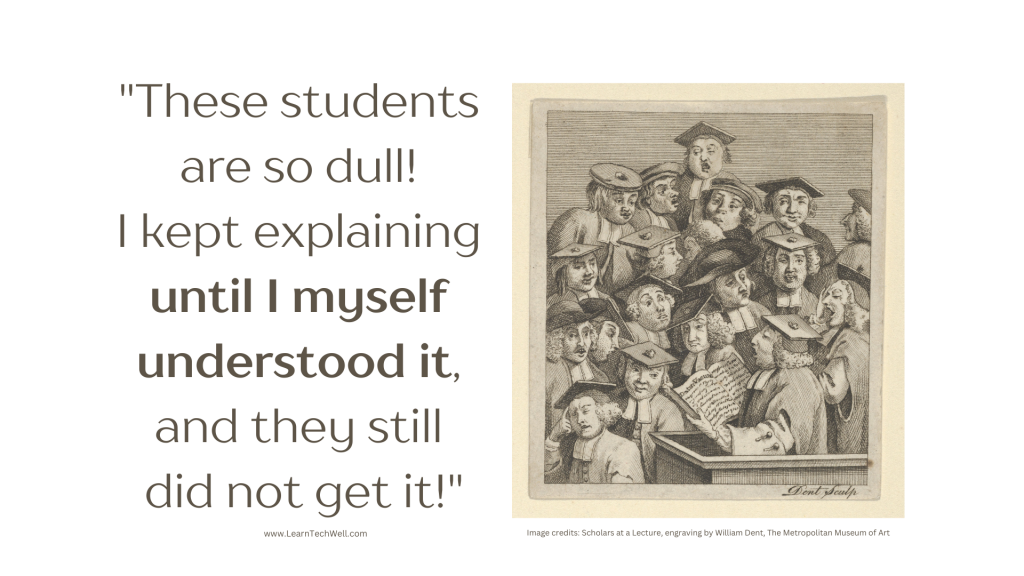What is understanding and how can you boost it?
Welcome to an adventure in understanding understanding! What can you do to improve your understanding? How to understand what you are studying so you remember it? What are the building blocks of understanding?
Pages build into a book; brushstrokes build into a painting; steps build into a ladder. So, what is it that builds understanding? You’ll have a hard time finding an answer on the internet. Yet the building block is obvious when you look at it. So let’s dive in and see!
This explanation is practical. Apply the elements of understanding as you get to know them. Make these tips work for you by putting them into action!

How to improve understanding: start with words
A sea is made up of drops of water. A book is made up of pages. A text is made up of words. How do you come to understand a text? Well, by understanding the words that make it up. Does that seem too simple? Let’s read on and see!
A puzzle is a number of pieces. Each word in a text is like a piece of the puzzle. When you really understand each word, you have a solution to the puzzle.

What does it mean to really understand a word? To answer this question, let’s view it in reverse: how a word might be misunderstood.
5 different ways of misunderstanding a word
- No idea at all: you simply do not know a word. You’ve never heard of it or seen it before. You have no idea what it means. But is this the only way to miss your understanding of a word? Well, let’s read on!
- A made-up meaning: you guess what the word must mean. You make up the meaning based on the context or because it’s similar to other words. Sometimes your guess is right, but sometimes it is wrong. This is a hidden trap: you think you know it, but in fact, you might be missing the idea. It might be tricky to spot if you figured this out a while ago and the word seems clear enough to you. But with a bit of practice, you can see the difference between the words you really know and those you’ve “figured out” for yourself. Thinking about words on your own is all right. But check the meaning in a dictionary so you don’t end up with an incorrect understanding.
Example: A little girl thinks that a “park” means a “playground” because she used to go to a playground in a small park nearby. She is happy about the idea of traveling to a larger park. When she arrives at the larger park with grass and trees, she is quite upset that the playground isn’t there. - An incomplete meaning: you don’t know enough relevant details. You read “Chow Chow” and you understand it’s a dog. That was all you needed to know when you first heard it. But if your friend asked you to take care of her Chow Chow for a few days, you’d want to know more: how big is it? How long do you exercise it? How to keep it clean? Etc. If you have taken up the study of dogs to become a dog trainer, you’d also need to learn more details about Chow Chow.
Example: Before you started learning to code, you might have known that “HTTP” is a set of letters in the website name; but when you need to code “HTTP requests,” you need to understand this term deeper.
Example: You might know that “cat” can be used about a woman, but you don’t know if this is good or bad. The dictionary will tell you that it’s bad, it is an insult. - A different meaning: “Chow chow” is not only a dog but also a type of food. You might recognize “cat” as a cute pet, but do you know it also means a whip with nine knotted cords (cat-o’-nine-tails)? If you didn’t know the other meaning, you’d read the sentence “British sailors feared the cat” and get the idea that the sailors feared a domestic animal.
Example: A foreigner once insisted that in the phrase “Let’s grow big fast,” the word “fast” meant “eat no food for some time.”
Example: A would-be programmer tells his grandfather that he is now “learning to code”; the grandpa, who is of a military background, thinks his grandson is into secret military communications. - Substituting a word. Instead of understanding the word as it is, you mentally replace it with another word. This often happens when someone is learning a foreign language. For example, instead of learning the English word “table”, a foreigner replaces it with a word in his native language and thinks he understands “table.” (This is a whole subject in itself. Please comment if you would like to read up on this.)
Now that you know what a misunderstood word is, you can see if you really understand various words.
Symbols can also be misunderstood
Not only words but also symbols (such as *, #, etc.) might be misunderstood in any of the above ways.
In learning a foreign language, the first step is to understand the symbols of its alphabet. The second thing is to understand the symbols of transcription: how to say the words. Once you get this down, you can build up your knowledge of that language.
How to clarify a word that is not fully understood
Great, you spotted a possible misunderstanding of a word! Let’s resolve this and come to an understanding. Steps to follow to understand a word:
- Look it up in a dictionary or an encyclopedia or Google it. A good source of data would have all the necessary information, but not so much as to overload and confuse you. It would explain it in simple terms, so you don’t get stuck trying to understand another word that is used in the explanation. Find a simple explanation that applies to the context and read it.
- Find out where that word came from. This might help you understand the basic, core idea of the word.
- Make it your own: use it in a few sentences or come up with several examples of it. If the word has more than one meaning, do these steps with all of them.
How to tell if you fully understand a word
You understand a word fully when you have a direct idea of it. The idea is not dependent on your memory. It is not dependent on other words, pictures, or anything else. You just know it. Just like you know what a “home” is: you don’t think of the picture or the address, you just know. Knowing is the ultimate level of understanding.
Example: You hear someone yelling “Watch out for that car!” You don’t know these words well and start groping for the meanings of “watch, out, for, that, car.” By the time your mental machinery has delivered up these meanings, it might be too late! However, when you have a direct idea, or a concept, of a car, you don’t need to spend any time remembering it. The idea of a car might be described as follows: a heavier-than-you, fast-moving vehicle that transports people and things from one place to another. These words are symbols that help communicate a mental idea without telepathy. The idea itself is neither a word nor a set of words. It is a thought or a concept in your mind.

You arrive at the idea or concept of the word through these main stages:
- Read a clear and detailed explanation of it, and
- Make it your own by making sentences with it, giving examples, drawing, etc.
When you’ve made it your own, the word is fully understood.
When you really understand a word, it makes you happy!
If you are not happy with your understanding of a word, you can remedy this. Check if there is another word not understood. Maybe you have too few or too many examples. Or maybe something is distracting you from your studies.
Learning can be joyful when you get to understand unfamiliar words.
Put into action. Let’s try it out. Pick up a word that you are not sure about. Look it up and follow the steps above to understand it. Could you follow them? Did it make you feel better? Please write about it in the comments! Do take the time to understand at least one word in this way. How else would you know if this helps you?
Do you need to know ALL the words?
“It’s awfully slow reading if I have to know ALL the words,” you might say. Speed reading manuals tell you to skip words you don’t understand.
Think of this: would you want to get treated by a doctor who skipped words and ideas not fully understood when he studied medicine?
Now let’s also take a different angle. Say, our doctor decided to put up a simple website to promote himself. He picked up a website manual full of complex computer terminology. The doctor could be excused for skipping any part of the manual that wasn’t relevant to his purpose: to build one website. The doctor is not intending to be a computer whiz; he wants to learn just enough to put up his website.
The purpose is the key factor. Ask yourself: “What am I studying the subject for? What do I want to achieve with it?” If you intend to end up with a deep understanding and application, you want to study it thoroughly, with no shortcuts.
When you really understand everything as you progress, you are happy and satisfied. When you don’t understand something, you get frustrated and often want to drop your studies.
In my experience, to avoid study upsets, it is better to have at least some degree of understanding of any word that you run into. When you have a basic understanding, you can decide whether you want to dig deeper into it.
Even if looking up words seems to slow you down at first, it pays off in the long run: you build up a mental library of well-known words. The more you understand, the easier it is to understand the next thing that comes your way. You may start out slowly, but you end up smart.
If your purpose is to really know and understand a subject, you achieve it by understanding all the words that compose it.
Put into action. Ask yourself about your purpose. Why do you study? Are you learning to code so you can create efficient applications? Are you learning photography so you can make high-quality photographs? Or are you studying only to pass the test and have nothing to do with this subject ever after? How deep do you feel your understanding should be?
The depth of understanding required depends on your purpose
Once you know the purpose, you can select the right tools to achieve it.
Understanding is not black-and-white. It is a gradient scale or a spectrum. On one end of this scale or spectrum is “deep, thorough understanding,” and on the other end is “no understanding at all.” You are somewhere in between.

Your understanding should be as deep as required for your purpose, or a bit deeper if you wish to excel in your field.
For example, you want to study the makeup of the universe. You read an explanation: “all things are made of atoms—little particles that move around in perpetual motion, attracting each other when they are a little distance apart, but repelling upon being squeezed into one another.” (This is an explanation by Richard Feynman, a Nobel laureate in physics.) From this sentence, you’ve gained a beginner-level understanding of the subject. Maybe you don’t need to go any deeper. But if you want to be a physicist and aim for a Nobel Prize, you would seek a deeper understanding.
The trick is finding your balance: just enough understanding for your purpose.
How to gain an understanding of a subject or a concept
We learned about your understanding of individual words. We took your purpose into account. Now let’s put it all together and see how you would understand a subject.
1. Your key to understanding a subject is its basic terminology
“The great art of learning is to understand but little at a time.”
John Locke (1632 – 1704), one of the most influential Enlightenment thinkers.
To understand a subject, you first want to get a firm grip on its fundamentals: its key terminology and basic concepts. Get a text that defines the basics of that subject. Study it and make sure you fully understand each word being used. This is the foundation on which the building of your knowledge will be constructed.
Put into action. Can you spot a basic term in the subject you are currently learning that you could increase your understanding of? Please take the time to do this and share it in the comments!
2. Make use of multiple sources of information
See if you can find more than one source of data on your subject. Try using a variety of content types, such as text, audio, video, and graphics. Scientists have found that using multiple types of content helps people retain ideas in their memory. And by getting different explanations of your subject from different people, you get a broader view of it.
As an example, when I was learning to drive, my driving instructor did not explain well enough how to execute turns. Then I found an online instructor who put out a series of videos on where to look when making a turn. I watched all of his videos and they helped me, but I still felt unsatisfied. Then I found another online instructor who showed in detail where you put your foot as you make a turn. This was the last missing piece of the puzzle. Thus, the different sources of data added up to a clear understanding of how to handle turns.
3. Read the principal texts aloud
When you really want to understand and remember a text, read it out loud. Scientific studies demonstrate that students who read information aloud learn faster than those who do so silently.
Make sure you understand what you’re reading. Don’t be a voice-over machine. Imagine that you are giving a lecture on this subject. If you stumble when reading the text aloud or if you realize that you are doing it mechanically, stop. Get back to where you really understood what you were reading. Be prepared to discover a word that you had not fully understood toward the end of what you thought you understood well. Clarify what you missed, increase your understanding, and then continue reading the text aloud.
Put into action. Read the last paragraph out loud. Did your understanding deepen when you read it aloud?
4. Go beyond the text: observe and practice
Theory works best when it is put into practice. As the first gradient of practice, you can draw, sketch, or use pens and other objects on your table to show what you are trying to learn. For example, you are studying relationships. You take your pen and pencil: “This pen is Joe, and this pencil is Mary. Joe says ‘Hi’ to Mary (a paperclip travels from pen to pencil). Now Mary…”
You may also make drawings of things you study. This is most common in engineering. You can also use a free graphic organizer to increase your understanding by plotting the relationships between different ideas.
The most reliable test of your understanding is the practice of your subject. Try doing something with it. If you are a student of coding, do some coding. If you are studying math, solve a math problem. Balance theory and practice. Scientists refer to practice as one of the best ways to improve learning.
Another source of understanding is observation: we look at various parts of the subject. We don’t take someone’s word for it, but we look. Let’s say you are studying colors. By looking at various colors and their combinations, you will get much more than just reading about colors.
Put into action. Use some objects on your table for practice: show yourself studying something and achieving the purpose you had set for this study.
5. When you help another to understand, both of you benefit
A smart way to increase your understanding of a subject is to try and explain it to someone else. If you describe it in simple terms for another, you can better understand and remember it. This is also a fine way to spot things that you cannot explain because they are not fully clear. Then you can clarify them and arrive at a deeper understanding.
When you understand something, it is very easy to convey it to another.

Put into action. Explain to someone else something you learned today. You can explain it verbally or post it on social media.
6. Strengthen your purpose: Invest time or money you cannot afford to lose
Learning a subject normally takes time. If you’re learning on your own, rather than attending a class, you will run into things that distract you. To help you fight distractions, first define a purpose that motivates you. And then invest time or money you cannot afford to lose. Or make a public challenge that you would really be uncomfortable not upholding.
Overcoming study difficulties
At the first sign of difficulty understanding a subject, check its words: do you understand them all, and do you understand them fully?
If you’ve been studying something and it has become incomprehensible, go back to the last point that was totally clear to you. Re-study it and go on from there. Quite often you’ll find that at the very end of the part that was understood, there was something you did not fully grasp. This might be a word that is not fully understood. There may be a part of an action that you haven’t quite mastered. Whatever it is, get it clarified or mastered so you feel confident about it.
It’s not enough to just check the “difficult” words. I have seen native speakers of English who did not actually know some of the common English words.
The most effective thing to do when you have trouble learning anything: check if there are any words in that subject, or an earlier subject, that you did not fully understand. Find them and look them up.
Our awareness in general, and our ability to learn and understand things, are also affected by our physical condition. Experts recommend that we drink enough water, eat healthily, exercise, and get enough sleep. Below are some of the scientific ways to take care of yourself so that your physical condition is not getting in the way of your understanding.
Take breaks
When you’ve studied for however long you intended to, take a break. After the break, go over what you studied last time and see if it’s fully clear to you. If you do this, you will remember the data much better, according to scientific research. Increased learning effectiveness by taking breaks between study sessions is called the “spacing effect.”
Breaks are not a waste of time. They help your mind to rest. You unfocus your attention, you look at other things; when you return, you have a renewed focus. Scientists who have studied this phenomenon concluded that “rest is best.”
Many programmers have noticed that taking a break helps them find solutions. A friend of mine shared an experience: she’d been sitting in front of a computer for a few hours trying to find a solution to a problem. Finally, she gave up and walked away for lunch. When she came back to the computer, she immediately spotted which line of code had been giving her trouble.
Remove distractions
Turn off notifications on your phone and computer. Be in a comfortable environment that helps you focus on what you’re studying. Scientists have found that distractions reduce your ability to learn.
Use breaks to unfocus. Between the breaks, devote your undivided attention to your studies.
Overcome negative emotions associated with studies
Some words or subjects have emotions associated with them. For instance, if someone had a lot of trouble with math at school, he or she might not want to hear “math” ever again, much less try to understand it. Now that you know this, you can recognize it if it happens.
If you have had an emotional experience that gets in the way of your studies, see if you can find a sympathetic person that would be willing to listen to your story. If you observe another person having this problem, let them talk about it. Let them express their emotions. Sometimes a word is associated with more than one negative experience. It is possible to examine the past in search of these and talk about it until one feels better.
Key takeaways:
- You can understand words by looking them up and making examples until the word is clear; this is fun!
- A word can be misunderstood in several ways which include: an incomplete idea, a made-up meaning, an inapplicable meaning, etc.
- An understood word is one that you have an idea of without having to “think of” or “remember.” You just know.
- The most effective way to understand a word is to connect it with your own life through examples and sentences.
- The depth of understanding required depends on your purpose
- By understanding words, you can better understand a subject
- Observation and practice contribute to understanding
- Study many different sources, not just one
- Explaining to another improves your own understanding
Conclusion
Thank you, brave soul, for making it this far! “Understanding” is one of the 1000 most common English words. But few people get to ask themselves what it means. You now know more about it than most people! Please share what you took away from this article in the comment section below. And please sign up for our mailing list so you can get to know more things that help you learn and understand modern technology!
About the author
As a lifelong learner, I spent years gathering science-backed workable ways to bring about understanding. If you want to learn so that you really understand and can apply, I will do my best to share helpful tips with you. And if you only want to get good grades and never hear of that subject ever again, well, maybe this is not quite for you – unless you want to consider a different way of studying!
Usually I do not read article on blogs, however I would like to say that this writeup very compelled me to take a look at and do it. Your writing style has been amazed me. Thank you very nice article